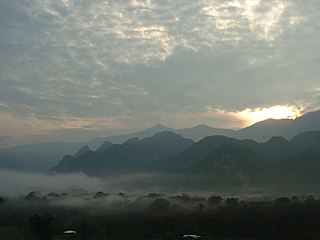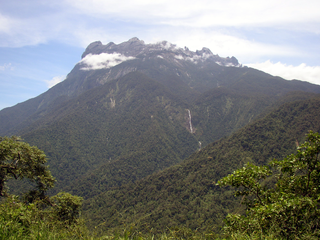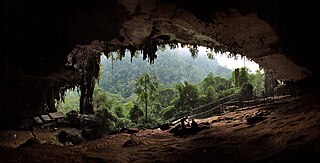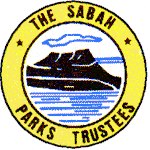 W
WThe National Parks Act 1980 is a Malaysian federal law that governs the creation and the maintenance national parks in Malaysia. It was created in 1980 during the controversy surrounding the protection of Endau Rompin forest complex. The act provides for the states to establish national parks to be administered by Department of Wildlife and National Parks under the federal government.
 W
WBako National Park is a national park in Kuching Division, Sarawak, Malaysia. Established in 1957, it is the oldest national park in Sarawak. It covers an area of 27.27 square kilometres (10.53 sq mi) at the tip of the Muara Tebas peninsula at the mouth of the Bako and Kuching Rivers. It is approximately 40 kilometres (25 mi) by road from Kuching. Millions of years of erosion of the sandstone have created a coastline of steep cliffs, rocky headlands and stretches of white, sandy bays. Wave erosion at the base of the cliffs has carved many of the rocky headlands into fantastically shaped sea arches and seastacks with colored patterns formed by iron deposition. The most famous of them is shaped like a cobra's head which can be spotted on a boat ride from the headquarters or one of the beaches. Some of these rock formations can be seen on entry to the Teluk Assam Beach, which fronts the park. The park can only be reached by a 20-minute boat ride from the village of Kampung Bako. It is often visited as a day-trip from Kuching, though accommodations are available.
 W
WBatang Ai National Park is a national park located in Sri Aman Division, Sarawak, Malaysia. It is located in Lubok Antu, some 250 kilometers east of Kuching. The park covers an area of 24 square kilometres (9.3 sq mi) of extensive tropical rainforest with a number or rare and protected animals surrounding the 24 square kilometer artificial lake created by the Batang Ai hydroelectric reservoir. The park was proclaimed in 1991, and has become increasingly popular with locals and tourists despite the lack of facilities.
 W
WThe Bukit Tiban National Park is a national park in Bintulu Division, Sarawak, Malaysia. The park encloses the headwaters of the Sungai Nyalau and Sungai Timong rivers in the Miri Division and Sungai Sigrok, a tributary of Sungai Similajau in the Bintulu Division.
 W
WCrocker Range National Park was established in 1984, although the area had previously been under protection as a forest reserve. It covers the north-south Crocker Range, of 1200-1800 metre mountains in Sabah, Malaysia. In the vicinity of park headquarters, there is a resort that provides accommodation and food services. Other visitors facilities such as an exhibition centre, insectarium, fernarium, observation tower and trekking trail can also be found.
 W
WEndau-Rompin National Park is a protected tropical rainforest in the southernmost prolongation of the Tenasserim Hills, Malaysia. It is south of the state of Pahang and northeast of Johor covering an area of approximately 870 km2 (340 sq mi), making it the second-largest national park in Peninsular Malaysia after Taman Negara. It has approximately 26 km (16 mi) of trail. It is the second national park proclaimed by the government of Malaysia. Gunung Besar, the second-highest peak in Johor, is in the park.
 W
WThe Gunung Gading National Park is a national park in Kuching Division, Sarawak, Malaysia. The park is located roughly two hours drive from Kuching, and is a popular destination for seeing the Rafflesia flower in bloom. After 10 years as a conservation zone to protect the Rafflesia, the park opened to visitors in 1994. The park also has a number of jungle trails to waterfalls or to the 965m summit of Gunung Gading.
 W
WThe Gunung Ledang National Park is a national park in Tangkak District, Malaysia. which contains the 1,276 m peak of Mount Ophir. It was established in 2005, and now it is one of the most famous hiking goals in the nation.
 W
WThe Gunung Mulu National Park is a national park in Miri Division, Sarawak, Malaysia. It is a UNESCO World Heritage Site that encompasses caves and karst formations in a mountainous equatorial rainforest setting. The park is famous for its caves and the expeditions that have been mounted to explore them and their surrounding rainforest, most notably the Royal Geographical Society Expedition of 1977–1978, which saw over 100 scientists in the field for 15 months. This initiated a series of over 20 expeditions now named the Mulu Caves Project.
 W
WKinabalu Park, established as one of the first national parks of Malaysia in 1964, is Malaysia's first World Heritage Site designated by UNESCO in December 2000 for its "outstanding universal values" and the role as one of the most important biological sites in the world with more than 4,500 species of flora and fauna, including 326 bird and around 100 mammal species, and over 110 land snail species.
 W
WThe Kubah National Park is a national park in Kuching Division, Sarawak, Malaysia.
 W
WThe Kuching Wetlands National Park is a national park in Sarawak, Malaysia. It is the remains of the former Sarawak Mangrove Forest Reserve which covered 170 km2.
 W
WThe Lambir Hills National Park is a national park in Miri Division, Sarawak, Malaysia, on the island of Borneo. It is a small park, at 6,952 hectares, and is composed largely of mixed dipterocarp forest, with some small areas of 'kerangas'. The park is 150–465 m (492–1,526 ft) above sea level.
 W
WThe Loagan Bunut National Park is a national park located in Miri Division, Sarawak, Malaysia, on the Borneo island. The park was named after the Loagan Bunut lake nearby, which is connected to Sungai Bunut, Sungai Baram and Sungai Tinjar. This park occupies a space of 100 km2 (39 sq mi) and is well known for its rich biodiversity and unique aquatic ecosystem.
 W
WMaludam National Park is a national park in Betong Division, Sarawak, Malaysia on the island of Borneo. It is located in the Maludam Peninsula and consists entirely of low-lying, flat peat swamp forest. Such forests cover about 10% of the total land area of Sarawak, but have mostly been exploited for timber and plantation agriculture. The Maludam National Park encompasses the largest single patch of peat swamp forest remaining in Sarawak and Brunei.
 W
WNiah National Park, located within Miri Division, Sarawak, Malaysia, is the site of the Niah Caves limestone cave and archeological site.
 W
WThe Penang National Park spans 1,213ha of land and sea and is used by scientists, researchers, and nature lovers to explore its natural treasures.
 W
WThe Pulong Tau National Park is a national park in the Kelabit Highlands of Sarawak, Malaysia, on the island of Borneo.
 W
WThe Rajang Mangroves National Park is a national park in Sarikei Division, Sarawak, Malaysia. It is home to species such as proboscis monkeys, silvered langurs, lesser adjutant storks and hornbills. .
 W
WSabah Parks is a conservation-based statutory body established in 1964 with the purpose of conserving the scenic, scientific and historic heritage of the state of Sabah, Malaysia, on the island of Borneo. The organisation is also responsible for the management and promotion of the various protected reserves in Sabah, in particular those designated as national parks. It is also mandated to develop tourism-friendly facilities to accommodate tourist arrivals to these reserves and ensure that the state of the reserves is not compromised. The first choice for inclusion in a park system was Mount Kinabalu. As a result, Kinabalu Park was gazetted in 1964, and today it is designated as a World Heritage Site.
 W
WThe Santubong National Park is a national park in Kuching Division, Sarawak, Malaysia, 35 km north of Kuching. It contains the 810m peak of Mount Santubong and surrounding rainforested slopes. There are a number of jungle treks in the park, including to the peak. Wildlife in the park include proboscis monkeys and rhinoceros hornbills.
 W
WThe Selangor State Park is a park located in Gombak District, Selangor, Malaysia. The 914.41 square kilometre park was gazetted on by the state on January 25, 2007. Upon its establishment, it became the second largest park in Peninsular Malaysia with the largest being the Taman Negara.
 W
WSimilajau National Park is a national park in the Bintulu Division of Sarawak, Malaysia. It is located about 30 kilometres (19 mi) from Bintulu.
 W
WThe Talang Satang National Park is a national park in Kuching Division, Sarawak, Malaysia. It is Sarawak's first marine protected area, and covers the four islands Pulau Talang-Talang Besar, Pulau Talang-Talang Kecil, Pulau Satang Besar and Pulau Satang Kecil and surrounding coral reefs.
 W
WTaman Negara is a national park in Peninsular Malaysia. It was established in 1938/1939 as the King George V National Park after Theodore Hubback lobbied the sultans of Pahang, Terengganu and Kelantan to set aside a piece of land that covers the three states for the creation of a protected area. It was renamed Taman Negara after independence, which means "national park" in Malay. Taman Negara has a total area of 4,343 km2 and it is one of the world's oldest deciduous rainforests, estimated to be more than 130 million years old.
 W
WThe Tanjung Datu National Park is a national park located in Kuching Division, Sarawak, Malaysia. It is situated in the far west of the state and covers an area of 14 square kilometers.
 W
WTawau Hills Park, was established in 1979, primarily as a protection for the water catchment area of Tawau town, Sabah, Malaysia. It is located 24 kilometres from Tawau, and comprises 279.72 km² of lowland dipterocarp rainforest, surrounded by oil palm and cacao plantations. The park offers picnic areas, camping sites, and chalets. The Park contains rugged volcanic landscapes including a hot spring and spectacular waterfalls. The highest point in the park is Gunung Magdalena. It is administered by the Sabah Parks.
 W
WTiga Island Park was established in 1978, although the area has been under protection as a forest reserve since 1933. It is located north of Kuala Penyu, opposite the swampy Klias Peninsula, in Sabah, Malaysia.
 W
WTun Mustapha Marine Park is a marine park located off the north coast of the state of Sabah, Malaysia. It comprises an area of 898,762.76 hectares with more than 50 islands and islets located across Kudat, Pitas and Kota Marudu districts.
 W
WTun Sakaran Marine Park, also known as Semporna Islands Park, is a marine park located off the east coast of Sabah, Malaysia. It consists of the islands of Bodgaya, Boheydulang, Sabangkat, and Salakan, the sand cays of Maiga, Sibuan, and Mantabuan, and the patch reefs of Church and Kapikan. In 2004, the park became the seventh gazetted area under Sabah Parks with a total area of 350 km². There are approximately 2,000 people living within the park, most of whom consist of the nomadic Bajau Laut people, who live in stilt houses and houseboats in and around the marine park.
 W
WThe Tunku Abdul Rahman National Park comprises a group of 5 islands located between 3 and 8 km off Kota Kinabalu in Sabah, Malaysia. The park is spread over 4,929 hectares, two-thirds of which cover the sea. Before the Ice age, it formed part of the Crocker Range mass of sandstone and sedimentary rock on the mainland. However, about one million years ago, the melting ice brought about changes in the sea level and parts of the mainland were cut off by the sea to form the islands of Gaya, Sapi, Manukan, Mamutik and Sulug. Evidence of this can be seen from the exposed sandstone of the coastline forming the cliffs, caves, honeycombs and deep crevices. The park was named after Tunku Abdul Rahman, Malaysia's first Prime Minister.
 W
WTurtle Islands Park is located within the Turtle Islands, which lie in the Sulu Sea some 3 kilometres north of Sandakan in Sabah, Malaysia. It consists of 3 islands - Selingaan, Little Bakkungan and Gulisaan, including the surrounding coral reefs and ocean. The Park is noted for its green turtles and hawksbill turtles which lay their eggs on the beaches of the islands. The Park covers an area of 17.4 km². The name Turtle Islands, however, refers to 10 islands, 3 of which are part of Turtle Islands Park of Malaysia, and 7 which belong to the Turtle Islands Wildlife Sanctuary of Tawi-Tawi province, Philippines.